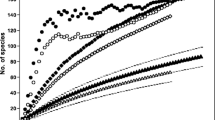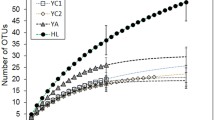Abstract
Pine species have become invasive throughout the globe and threaten to replace native biota. The threat of pine invasion is particularly pressing in parts of the tropics where there are no native pines. The factors that govern pine invasion are not often well understood. However, key to pine survival is an obligate and mutualistic interaction with ectomycorrhizal fungi. Thus for pines to successfully invade new habitats compatible ectomycorrhizal fungi must already be present, or be co-introduced. The purpose of this study was to examine the community structure of non-native ectomycorrhizal fungi associated with pine invasions in the Hawaiian Islands. To accomplish this we executed a field and greenhouse study and used a molecular ecology approach to identify the fungi associating with invasive pines in Hawai‘i. We show that: (1) ectomycorrhizal fungal species richness in non-native pine plantations is far less than what is found in pine’s native range, (2) there was a significant decrease in average ectomycorrhizal fungal species richness as distance from pine plantations increased and, (3) Suillus species were the dominant fungi colonizing pines outside plantations. The keystone ectomycorrhizal fungal taxa responsible for pine establishment in Hawai‘i are within genera commonly associated with pine invasions throughout the globe. We surmise that these fungi share functional traits such as the ability for long-distance dispersal from plantations and host tree colonization via spore that lead to their success when introduced to new habitats.


Similar content being viewed by others
References
Allen EB, Allen MF, Helm DJ, Trappe JM, Molina R, Rincon E (1995) Patterns and regulation of mycorrhizal plant and fungal diversity. Plant Soil 170:47–62
Ashkannejhad S, Horton TR (2006) Ectomycorrhizal ecology under primary succession on coastal sand dunes: interactions involving Pinus contorta, suilloid fungi and deer. New Phytol 169:345–354
Baar J, Horton TR, Kretzer A, Bruns TD (1999) Mycorrhizal recolonization of Pinus muricata from resistant propagules after a stand-replacing wildfire. New Phytol 143:409–418
Bruns TD, Peay KG, Boynton PJ, Grubisha LC, Hynson NA, Nguyen NH, Rosenstock NP (2009) Inoculum potential of Rhizopogon spores increases with time over the first 4 yr of a 99 yr spore burial experiment. New Phytol 181:463–470
Cadotte MW (2006) Dispersal and species diversity: a meta-analysis. Am Nat 167:913–924
Chapela IH, Osher LJ, Horton TR, Henn MR (2001) Ectomycorrhizal fungi introduced with exotic pine plantations induce soil carbon depletion. Soil Biol Biochem 33:1733–1740
Cody ML (2006) Plants on islands: diversity and dynamics on a continental archipelago. University of California Press, Berkeley, CA
Collier FA, Bidartondo MI (2009) Waiting for fungi: the ectomycorrhizal invasion of lowland heathlands. J Ecol 97:950–963
Deacon J, Fleming LV (1992) Interactions of ectomycorrhizal fungi. In: Allen Michael (ed) Mycorrhizal functioning: an integrative plant–fungal process. Chapman & Hall, New York, NY, pp 249–300
Dickie IA, Bolstridge N, Cooper JA, Peltzer DA (2010) Co-invasion by Pinus and its mycorrhizal fungi. New Phytol 187:475–484
Dickie IA, Yeates GW, St. John MG, Stevenson BA, Scott JT, Rillig MC, Peltzer DA, Orwin KH, Kirschbaum MUF, Hunt JE (2011) Ecosystem service and biodiversity trade-offs in two woody successions. J Appl Ecol 48:926–934
Dodet M, Collet C (2012) When should exotic forest plantation tree species be considered as an invasive threat and how should we treat them? Biol Invasions 14:1765–1778
Dunstan W, Dell B, Malajczuk N (1998) The diversity of ectomycorrhizal fungi associated with introduced Pinus spp. in the Southern Hemisphere, with particular reference to Western Australia. Mycorrhiza 8:71–79
Entsminger GL (2012) EcoSim Professional: Null modeling software for ecologists, Version 1, Acquired Intelligence Inc., Kesey-Bear, & Pinyon Publishing, Montrose, CO 81403. http://www.garyentsminger.com/ecosim/index.htm
Funk JL, Vitousek PM (2007) Resource-use efficiency and plant invasion in low-resource systems. Nature 446:1079–1081
Gardes M, Bruns TD (1993) ITS primers with enhanced specificity for Basidiomycetes—application to the identification of mycorrhizae and rusts. Mol Ecol 2:113–118
Gardes M, Bruns TD (1996) Community structure of ectomycorrhizal fungi in a Pinus muricata forest: above- and below-ground views. Can J Bot 74:1572–1583
Giachini AJ, Oliveira VL, Castellano MA, Trappe JM (2000) Ectomycorrhizal fungi in Eucalyptus and Pinus plantations in southern Brazil. Mycologia 92:1166–1177
Grelet GA, Johnson D, Paterson E, Anderson IC, Alexander IJ (2009) Reciprocal carbon and nitrogen transfer between an ericaceous dwarf shrub and fungi isolated from Piceirhiza bicolorata ectomycorrhizas. New Phytol 182:359–366
Hoeksema JD, Hernandez JV, Rogers DR, Mendoza LL, Thompson JN (2012) Geographic divergence in a species-rich symbiosis: interactions between Monterey pines and ectomycorrhizal fungi. Ecology 93:2274–2285
Ikuma EK, Sugano D, Mardfin JK (2002) Filling the gaps in the fight against invasive species. Legislative Reference Bureau, Honolulu, HI
Ishida TA, Nara K, Tanaka M, Kinoshita A, Hogetsu T (2008) Germination and infectivity of ectomycorrhizal fungal spores in relation to their ecological traits during primary succession. New Phytol 180:491–500
Izzo AD, Meyer M, North M, Trappe JM, Bruns TD (2005) Hypogeous ectomycorrhizal fungal species on roots and in small mammal diet in a mixed conifer forest. For Sci 53:243–254
Izzo AD, Nguyen DT, Bruns TD (2006) Spatial structure and richness of ectomycorrhizal fungi colonizing bioassay seedlings from resistant propagules in a Sierra Nevada forest: comparisons using two hosts that exhibit different seedling establishment patterns. Mycologia 98:374–383
Kagawa A, Sack L, Duarte K, James S (2009) Hawaiian native forest conserves water relative to timber plantation: species and stand traits influence water use. Ecol Appl 19:1429–1443
Klironomos JN (2002) Feedback with soil biota contributes to plant rarity and invasiveness in communities. Nature 417:67–70
Kohout P, Sykorová Z, Bahram M, Hadincová V, Albrechtová J, Tedersoo L, Vohník M (2011) Ericaceous dwarf shrubs affect ectomycorrhizal fungal community of the invasive Pinus strobus and native Pinus sylvestris in a pot experiment. Mycorrhiza 21:403–412
Koske RE, Gemma JN, Flynn T (1992) Mycorrhizae in Hawaiian angiosperms: a survey with implications for the origin of the native flora. Am J Bot 79:853–862
Lanner RM (1966) The phenology and growth habits of pines in Hawai‘i. Pacific Southwest Forest and Range Experiment Station, Forest Service, US Department of Agriculture
Levine JM, Vila M, D’Antonio CM, Dukes JS, Grigulis K, Lavorel S (2003) Mechanisms underlying the impacts of exotic plant invasions. Proc R Soc Lond B Biol Sci 270:775–781
Little EL, Skolmen RG (1989) Common forest trees of Hawai‘i (native and introduced). Forest Service, United States Department of Agriculture
MacArthur RH, Wilson EO (1967) The theory of island biogeography. Princeton University Press, Princeton, NJ
MacDougall AB, Gilbert B, Levine JM (2009) Plant invasions and the niche. J Ecol 97:609–615
Mack RN, Simberloff D, Lonsdale WM, Evans H, Clout M, Bazzaz FA (2000) Biotic invasions: causes, epidemiology, global consequences, and control. Ecol Appl 10:689–710
Mikola P (1988) Ectendomycorrhiza of conifers. Silva Fennica 22:19–27
Mitchell CE, Agrawal AA, Bever JD, Gilbert GS, Hufbauer RA, Klironomos JN, Maron JL, Morris WF, Parker IM, Power AG (2006) Biotic interactions and plant invasions. Ecol Lett 9:726–740
Mooney HA, Drake A (eds) (1986) Ecology of biological invasions of North America and Hawai‘i. Springer, New York, NY
Nara K (2009) Spores of ectomycorrhizal fungi: ecological strategies for germination and dormancy. New Phytol 181:245–248
Nguyen NH, Hynson NA, Bruns TD (2012) Stayin’ Alive: unexpected survival of mycorrhizal spores from six year old forest soil. Fungal Ecol. http://dx.doi.org/10.1016/j.funeco.2012.05.006
Nouhra ER, Dominguez LS, Daniele GG, Longo S, Trappe JM, Claridge AW (2008) Ocurrence of ectomycorrhizal, hypogeous fungi in plantations of exotic tree species in central Argentina. Mycologia 100:752–759
Nuñez MA, Medley KA (2011) Pine invasions: climate predicts invasion success; something else predicts failure. Divers Distrib 17:703–713
Nuñez MA, Horton TR, Simberloff D (2009) Lack of belowground mutualisms hinders Pinaceae invasions. Ecology 90:2352–2359
Oppenheimer HL (2002) The spread of gymnosperms on Maui: a neglected element of the modern Hawaiian flora. In: Records of the Hawai‘i Biological Survey for 2000, Bishop Museum Occasional Papers, vol 68, pp 19–23
Orlovich DA, Cairney JG (2004) Ectomycorrhizal fungi in New Zealand: current perspectives and future directions. NZ J Bot 42:721–738
Peay KG, Bruns TD, Kennedy PG, Bergemann SE, Garbelotto M (2007) A strong species-area relationship for eukaryotic soil microbes: island size matters for ectomycorrhizal fungi. Ecol Lett 10:470–480
Peay KG, Kennedy PG, Bruns TD (2008) Fungal community ecology: a hybrid beast with a molecular master. Bioscience 58:799–810
Peay KG, Garbelotto M, Bruns TD (2010) Evidence of dispersal limitation in soil microorganisms: isolation reduces species richness on mycorrhizal tree islands. Ecology 91:3631–3640
Peay KG, Schubert MG, Nguyen NH, Bruns TD (2012) Measuring ectomycorrhizal fungal dispersal: macroecological patterns driven by microscopic propagules. Mol Ecol. doi:10.1111/j.1365-294X.2012.05666.x
Read DJ (1998) The mycorrhizal status of pines. In: Richarson DM (ed) Ecology and biogeography of Pinus. Cambridge University Press, Cambridge, pp 324–340
Richardson DM, Rejmánek M (2004) Conifers as invasive aliens: a global survey and predictive framework. Divers Distrib 10:321–331
Simberloff D (2006) Invasional meltdown 6 years later: important phenomenon, unfortunate metaphor, or both? Ecol Lett 9:912–919
Smith SE, Read DJ (2008) Mycorrhizal symbiosis, 3rd edn. Academic Press, London, UK
Taylor DL, Bruns TD (1999) Community structure of ectomycorrhizal fungi in a Pinus muricata forest: minimal overlap between the mature forest and resistant propagule communities. Mol Ecol 8:1837–1850
Tedersoo L, Suvi T, Beaver K, Koljalg U (2007) Ectomycorrhizal fungi of the Seychelles: diversity patterns and host shifts from the native Vateriopsis seychellarum (Dipterocarpaceae) and Intsia bijuga (Caesalpiniaceae) to the introduced Eucalyptus robusta (Myrtaceae), but not Pinus caribea (Pinaceae). New Phytol 175:321–333
Tedersoo L, May TW, Smith ME (2010) Ectomycorrhizal lifestyle in fungi: global diversity, distribution, and evolution of phylogenetic lineages. Mycorrhiza 20:217–263
Thiet RK, Boerner REJ (2007) Spatial patterns of ectomycorrhizal fungal inoculum in arbuscular mycorrhizal barrens communities: implications for controlling invasion by Pinus virginiana. Mycorrhiza 17:507–517
Vellinga EC, Wolfe BE, Pringle A (2009) Global patterns of ectomycorrhizal introductions. New Phytol 181:960–973
Vitousek PM, D’Antonio CM, Loope LL, Westbrooks R (1996) Biological invasions as global environmental change. Am Sci 84:468–478
Vralstad T, Fossheim T, Schumacher T (2000) Piceirhiza bicolorata—the ectomycorrhizal expression of the Hymenoscyphus ericae aggregate? New Phytol 145:549–563
Walbert K, Ramsfield TD, Ridgway HJ, Jones EE (2010) Ectomycorrhizal species associated with Pinus radiata in New Zealand including novel associations determined by molecular analysis. Mycorrhiza 20:209–215
White T, Bruns T, Lee S, Taylor J (1990) Amplification and direct sequencing of fungal ribosomal RNA genes for phylogenetics. In: Innis M, Gelfand D, Sninsky J, White T (eds) PCR protocols—a guide to methods and applications. Academic Press, New York, pp 315–322
Acknowledgments
The authors would like to thank Dr. Don Hemmes, Glenn Shishido, J.B. Friday, Mike Robinson and Patti Welton for assistance with locating, and permitting access to field sites. We would also like to thank Kabir Peay and Tom Bruns for their input on our experimental approach. We thank Timothy Chang and Charmaine Doan for their help with the greenhouse and lab portions of this study. Additionally, Anthony Amend, Peter Kennedy, Martin Nuñez, and Ian Dickie gave us very useful comments on earlier versions of this manuscript. We would also like to acknowledge the insightful feedback from three anonymous reviewers on this manuscript. Finally, we would like to thank the Hynson family on Maui who provided a home laboratory and assistance with soil sample transport.
Author information
Authors and Affiliations
Corresponding author
Electronic supplementary material
Below is the link to the electronic supplementary material.
Rights and permissions
About this article
Cite this article
Hynson, N.A., Merckx, V.S.F.T., Perry, B.A. et al. Identities and distributions of the co-invading ectomycorrhizal fungal symbionts of exotic pines in the Hawaiian Islands. Biol Invasions 15, 2373–2385 (2013). https://doi.org/10.1007/s10530-013-0458-3
Received:
Accepted:
Published:
Issue Date:
DOI: https://doi.org/10.1007/s10530-013-0458-3




